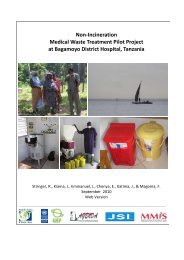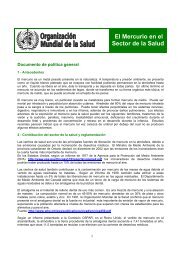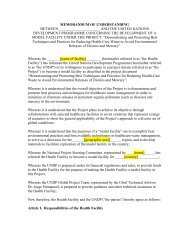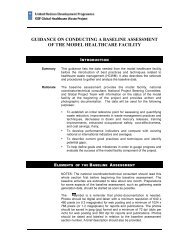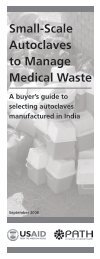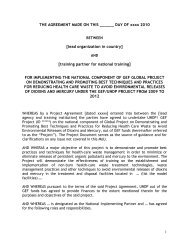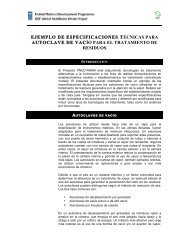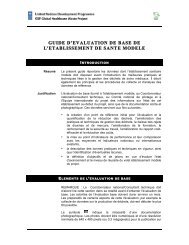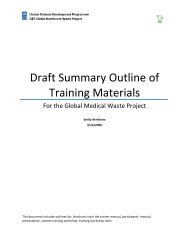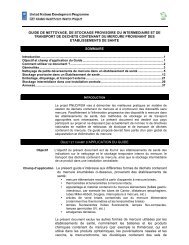Logical Framework - UN/GEF Global Healthcare Waste Project
Logical Framework - UN/GEF Global Healthcare Waste Project
Logical Framework - UN/GEF Global Healthcare Waste Project
You also want an ePaper? Increase the reach of your titles
YUMPU automatically turns print PDFs into web optimized ePapers that Google loves.
<strong>Logical</strong> <strong>Framework</strong> of Overall <strong>Project</strong> Strategy (LogFrame)<strong>Global</strong> Environment Facility/United Nations Development Programme <strong>Global</strong> <strong>Healthcare</strong> <strong>Waste</strong> <strong>Project</strong>:Demonstrating and Promoting Best Techniques and Practices for Reducing Health-Care <strong>Waste</strong> to Avoid Environmental Releases ofDioxins and MercuryGoal<strong>Global</strong> objective<strong>Project</strong> objectiveOutcome/Component 1Output 1<strong>Project</strong> strategyProtection of the global environmentand public health by reducingreleases of dioxins and mercuryReduction of barriers toimplementation of the StockholmConvention, International WatersGPA, SAICM and WHO policiesDemonstration and promotion of bestpractices and techniques for healthcarewaste managementBest practices for health-care wastemanagement demonstrated,documented and made replicable• Model facilities and programs areestablished and implemented.• Activities of modelfacilities/programs are documentedand their performance is evaluatedto exemplify best practices inhealth-care waste management.• Useful replication toolkits on howto implement best practices andtechniques are developed.Objectively verifiableindicators• Tools for baseline assessmentdeveloped/adapted and facilitybaseline assessment completed• System for measurement anddocumentation established• Health-care wastemanagement plan completedand implemented• Facility-wide traininginstituted• Practices at facility measured,evaluated and documented• Replication materials on bestpractices and techniquescreated and distributed• Replication materialsevaluatedSources of verification• Tool document and baselinereport• Guidelines for measurementand documentation of results• Health-care wastemanagement plan and itsimplementation records• Training curricula andprograms• List of training attendees• Facility-wide training reports• Quarterly and final reports onfacility activities• Replication materials• Replication toolkits and theirevaluation• <strong>Project</strong> websiteAssumptions and risks• Political and socialstability will bemaintained.• Full buy-in andcooperation from thehealth sector will bemaintained in the faceof urgent competingpriorities and demands.1
Outcome/Component 2<strong>Project</strong> strategyAppropriate non-incineration healthcarewaste treatment technologiessuccessfully deployed anddemonstrated• Commercially-available, nonincinerationhealth-care wastetreatment technologies that areappropriate to the needs of thefacility or cluster, and that satisfytheir needs, are purchased,deployed and evaluated.Objectively verifiableindicatorsSources of verificationAssumptions and risksOutput 2• Commercially-available nonincinerationtechnologiessuccessfully purchased anddeployed• Institutional needs satisfied• Environmental andperformance standardssatisfied• Use/efficiency and costimplications reported• Technologies operating atfacilities and photographs• Interviews with facilitymanagement• Reports covering microbialinactivation tests, use andcosts, throughput,environmental performanceand records of treatment cycles• <strong>Project</strong> website• Satisfactorytechnologies that meet<strong>Project</strong> demonstrationrequirements can bepurchased withinbudget (except for somefacilities in Africawhere research onlower cost alternativeswill be undertaken).• In the event thattechnologies will needto be imported, customsformalities will notsignificantly delay<strong>Project</strong> progress.• Facility managementwill honestly andaccurately report onfacility needs andtechnologyperformance.2
Outcome/Component 3Output 3<strong>Project</strong> strategyAffordable, non-incineration, healthcarewaste treatment technologiessuccessfully designed to meetAfrican needs and manufactured, andtheir replication plans in place• Appropriate, affordable, smallscalenon-incineration health-carewaste treatment technologies aredeveloped, tested, manufacturedand deployed for use in small- andmedium-sized facilities underconditions that prevail in much ofsub-Saharan Africa.• Blueprints and manuals formanufacture, installation,operation, maintenance and repairare prepared and disseminated.Objectively verifiableindicators• Needs assessment andperformance requirementscompleted for technologies tobe developed• Engineering designsdeveloped• Prototypes built and tested• Technology fabricationdemonstrated and technologyvalidated• Technology demonstrated andtested in a health-care setting• Manuals for construction,installation, operation,maintenance and repaircompleted and disseminated• At least one manufacturer inAfrica commerciallyconstructing new technologies,and a program in place toprovide assistance to otherpotential manufacturersSources of verification• Needs assessment report• Written performancespecifications• Engineering design drawingsand files• Digital photographs ofprototypes• Laboratory and field-testresults• Digital photographs offabricated technologies• Validation report• Reports on performance inhealth-care setting bydevelopers and users,including photographs• Manuals• Manufacturer business plan• Report on ongoing programsto assist potentialmanufacturers• <strong>Project</strong> websiteAssumptions and risks• Political and socialstability will bemaintained.• Locally available skillsand materials necessaryto build and repair thesetechnologies exist andwill be available.• Technologies can bedeveloped withinreasonable bounds ofcost and affordability.3
Outcome/Component 4Output 4<strong>Project</strong> strategyBest practices for management ofmercury waste demonstrated,documented and made replicable,and use of mercury-free devicespromoted* the latter will only be executed ifsuitable additional bilateral co-financingcan be secured.• Practices on safe handling anddisposal of phased-out mercurydevices are developed, stafftraining is completed and practicesare implemented in model facilitiesin a replicable way.• Affordable mercury-free devicesare purchased and introduced foracceptable and efficient use inmodel facilities.Objectively verifiableindicators• Guidelines on safe handlingand disposal of phased-outmercury devices developed• Training on mercury practicesorganized• Comparisons of the efficacy,acceptability, full costs, devicelifespan and other relevantcharacteristics of mercury-freeversus mercury-containingdevices carried out• Awareness-raising andeducational materials onmercury developed• Mercury conferences held,where applicable• Devices received and used bythe facilities• 80% of mercury devices infacilities replaced withmercury-free alternativesSources of verification• Guidelines on safe handlingand disposal of phased-outmercury devices• Training report• Reports on comparisons ofmercury-free versus mercurycontainingdevices• Mercury practicesimplementation report• Awareness-raising andeducational materials onmercury• Conference minutes, agendaand participant list• Interviews and evaluationreports from model facilitystaff and other participants• <strong>Project</strong> website• Device receipts and usagerecordsAssumptions and risks• Facility staff can beconvinced of theefficacy of non-mercurydevices and willhonestly and accuratelyreport on their efficacyand acceptability.• Political and economicconditions will notnegatively impact theacquisition or adoptionof mercury-freedevices.• Satisfactory mercuryfreedevices will beavailable at costs thatare consistent with<strong>Project</strong> replicationobjectives.4
Outcome/Component 5Output 5<strong>Project</strong> strategyNew and/or enhanced trainingprograms established to buildcapacity for the implementation ofbest practices and appropriatetechnologies beyond model facilitiesand programs• Effective national trainingprograms are established orenhanced and are building capacityin the health-care and relatedsectors for the implementation ofbest practices and the use ofappropriate technologies beyondmodel facilities and programs.Objectively verifiableindicators• Core curriculum developed• Partnership with hostinstitutions formalized• Training TORs/plandeveloped• At least two training sessionsconducted• Student certification programestablished, if applicable• Training evaluation completedSources of verification• Core curriculum documents• MOU with host traininginstitutions• Training reports with lists ofattendees• Test scores and copy of test ifapplicable• Copies of student certificates,if applicable• Training evaluation forms• Interview with employers• <strong>Project</strong> websiteAssumptions and risks• The training programwill target the mostappropriate personnel.• Non-<strong>Project</strong> facilitieswill be willing toimplement systems ofthe kind demonstratedby the <strong>Project</strong>, and arein a position toeffectively utilize theskills that the trainingprogram is designed toimpart.• Training programs willprovide knowledge thatspreads to otherpersonnel and willoutlast the <strong>Project</strong>itself.5
Outcome/Component 6Output 6<strong>Project</strong> strategyNational policies aimed at replicatingand sustaining best techniques andpractices demonstrated by the <strong>Project</strong>explored and, where feasible,initiated• Review of relevant nationalpolicies, regulations and guidelinesis conducted in light of <strong>Project</strong>experiences.• Appropriate policy updates orrevisions are recommended andfurther agreement andcommitments by relevantauthorities are pursued.• If appropriate, a national policyreview conference by relevantauthorities is held for thesepurposes.Objectively verifiableindicators• Relevant national policieslisted and analyzed in light of<strong>Project</strong> experiences• Consideration of updates orrevisions to relevantguidelines or other nationalpolicy instrumentsrecommended• Dialogue/interview withrelevant authorities (MOE,MOH, others) on possibleupdates or reformulations ofpolicies or guidelines aimed atreplicating and sustaining thedemonstrated best practices• National policy reviewconference held, if appropriateSources of verification• Review and recommendationreports• Government working papersand documents• Dialogue/interview notes• Conference minutes withparticipant list• <strong>Project</strong> websiteAssumptions and risks• <strong>Project</strong> countries willbe willing, given thepolitical and economicclimate, to undertake apolicy review aimed atpossible reformulationsand/or updates to theirpolicy instruments.• If policy updates arerecommended, therelevant stakeholderswill be able to institutethe recommendedchanges.6
Outcome/Component 7Output 7<strong>Project</strong> strategy<strong>Project</strong> results disseminated to allstakeholders for awareness-raisingaimed at their replication• <strong>Project</strong> results on best techniquesand practices are distributed torelevant federal and state ministriesor agencies, health service deliveryinstitutions and other stakeholders.• Targeted promotional materials,workbooks and other tools aredisseminated to promotewidespread replication.• Conferences or workshops are heldto encourage replication.• Agreement of relevant authoritiesis sought on an implementationplan for replication of bestpractices.Objectively verifiableindicators• Awareness-raising andeducational materialsdeveloped and localized• National conferences and/orworkshops held• Toolkits distributed andutilized• Public awareness campaignconducted to provideinformation to the generalpublic, patients and families• Interviews/dialogues withrelevant authorities held forfurther agreement orcommitment onimplementation plan forreplication of best practices• Local language materialsdistributedSources of verification• Awareness-raising andeducational materials• Conference agenda andparticipant lists• Number of toolkits distributed• List of stakeholders andstakeholder networks whohave been reached and reportson the manner by which theywere reached• Report on disseminationstrategies used• Reports on public awarenesscampaign• Report on evaluation ofeffectiveness• Interview/dialogue notes• List of receivers of materialsprinted in local languages• <strong>Project</strong> website and onlineresource access statisticsAssumptions and risksInformation andencouragement will notby themselves besufficient for securingbroad replication. Otherconditions prerequisite forreplication include:• Appropriate supportingpolicy instruments (asdescribed inComponent 4) will beput in place.• Human and economicresources will besufficiently available,relative to otherimportant health-carepriorities, to engage inthese activities.• Leadership at all levels,from the national to thestate to the facility, willbe able and willing toengage on theseimportant issues.7
Outcome/Component 8Output 8<strong>Project</strong> strategy<strong>Global</strong>, regional and nationalcounterparts from agencies,governments and NGOs beyondparticipating countries informed ofbest techniques and practices for thepurpose of replication• <strong>Project</strong> results on demonstratedbest techniques and practices aremade available for disseminationglobally and regionally.• <strong>Project</strong> materials are disseminatedthrough international and regionalnetworks.Objectively verifiableindicators• <strong>Project</strong>-related materialsdeveloped• <strong>Project</strong> results disseminated atinternational and regionalmeetings• <strong>Project</strong> website developed andupdated• Materials distributed• GEOLibrary augmented with<strong>Project</strong> resultsSources of verification• Materials related to <strong>Project</strong>results• List of international andregional stakeholders whoreceived results from <strong>Project</strong>partners• List of international andregional conferences wherepresentations were made andinformation was disseminated• <strong>Project</strong> website and onlineresource access statistics• List of people who receivedprinted materials• <strong>Project</strong>-specific content in theGEOLibraryAssumptions and risks• <strong>Global</strong> and regionaldissemination of<strong>Project</strong> results will notbe sufficient to globallyreform health-carewaste managementpractice. It is assumed,however, thatdemonstration results inthe <strong>Project</strong> countrieswill help informinterventions that maybe instituted in othercountries.8




